Authored by Shukurat Bisola Babalola*,
Abstract
Background: Gymnema sylvestre is a medicinal plant use in traditional medicine for management of various diseases. The present study investigated the phytochemical, anti-diabetic and hypoglycemic properties of the methanol leaves extract of Gymnema sylvestre in alloxan induced diabetic rats.
>Methods: A total of twenty (20) alloxan (120 mg/kg bw) induced diabetic rats were grouped into 4 (A-D) and treated with 0, 250 and 500 mg/ kg bw of methanol leave extract of Gymnema sylvestre and 2.5mg/kg bw glibenclimide respectively.
Results: Methanol leaves extract of Gymnema sylvestre contains saponin (23.85±2.35 mg/g) as the most abundant phytochemical in the extract followed by total phenol (19.77±0.55 mg/g), tannins (16.00±0.34 mg/g), alkaloids (13.84±0.06 mg/g) and total flavonoids (8.56±0.52 mg/g). The extract at doses of 250 and 500 mg/kg bw exhibited 81.75% and 82.12% in vivo hypoglycemic and increase the weight gain of animals when compared with untreated control. The extract at doses of 250 and 500 mg/kg also causes a significant (P<0.05) and dose dependent decrease in the elevated triglycerides (147.37±5.52 and 145.42±5.10 mg/dL), total cholesterol (132.30±16.88 and 130.25±21.10 mg/dL), and increase high density-lipoprotein (21.12±0.66 and 44.03±4.58 mg/dL) when compared with triglyceride (259.32±68.79 mg/dL), total cholesterol (228.45±4.36 mg/dL) and high density-lipoprotein (22.27±2.08mg/dL) in untreated rats.
Conclusion: Methanol leaf extract of Gymnema sylvestres contains important phytochemicals that has beneficial effect in reducing the elevated blood glucose level and significant ameliorative effects on hyperglycemic induced dyslipidemia.
Keywords:Gymnema sylvestre; Hypoglycaemia; Hypolipidemia; Diabetes; Phytochemicals
Introduction
Diabetes mellitus (DM) is metabolic abnormalities that arise due to insulin inadequacy and characterized primarily by high blood glucose level in addition to other secondary complications like hyperlipidemia, nephropathy organs failure, particularly, the kidney, heart, eyes, blood vessels and nerves [1]. Currently, over 150,000000 people on global basis are diabetic and this likely tends to increase to 300, 000000 before 2025.It is estimated that, 8.5% of adult’s population in 2014 are diabetes, and about 1.6 million diabetes associated deaths occur in 2016 [2]. The current available synthetic anti diabetic drugs have not been successful due to unintended hypoglycaemia and other side effects such renal and hepatic impairment, coma among many others [3]. Natural products particularly, from plants and medicinal insects represent rich sources of therapeutic agents against various diseases [4-6]. Hence, the exploration of natural products as alternative, safer and more effective anti-diabetics than the synthetic drug becomes the final hope for mankind.
Gymnema sylvestre is a woody, climbing plant commonly found in central and southern India and in parts of Africa [7]. Gymnema sylvestre plays an important role in Ayurvedic medicine of Nupe people in Niger State, Nigeria particularly for the management of diabetes mellitus and its associated conditions. The herb is also use in in folk medicine for the control of blood cholesterol levels and obesity and besides regulation of sugar homeostasis. Presently, G. sylvestre has gain global acceptance has herbal preparations in beverages, supplement, tablets, tea bags and confectioneries [7]. The plant has been reported for antimicrobial, anticancer and anti-inflammatory, properties. The plant is also use for the treatment of arthritis, Parkinsonism, dental caries Parimala DP and Ramasubramaniaraja R [8], rheumatism, stomachache and as blood purifier [9]. Phytochemical studies on G. sylvestre have revealed the presence of highly active saponins; gymnemic acids, gymnemasaponins (oleanane saponins) and gymnemasides (dammarane saponins) as the major contents [10-11]. This present study was thus designed to investigate the anti-diabetic and hypolipidemic activities of methanol leaves extract of Gymnemma stlvester in alloxan-induced diabetic rats.
Materials and Methods
Sample preparation and extraction
The freshly harvested leaves of Gymnema sylvestre were obtained from Minna area of Niger state Nigeria. Taxonomic authentication of the plant was conducted at the Department of Biology, Federal University of Technology, Minna. The leaves were thoroughly washed under running tap water to remove all contaminants after which they were cut into pieces, dried for 2 wk (37oC) and finally grounded using a grinder mill. A 50 g of the plant material was extracted with 200mL of methanol using soxhlet apparatus and the resulting extract was concentrated using rotary evaporator.
Experimental animal
Healthy Sprague Dawley rats of average weight (134.87±3.23) g were obtained from animal holding unit, Federal University of Technology, Minna, Niger State Nigeria. The rats were maintained under laboratory condition of temperature and humidity with 12-hour light and dark sequence. They were allowed access to rat pellets and water ad-libitum. The study was carried out according to the Guide for the Care and the Use of Laboratory Animals as contained in the Canadian Council on Animal Care Guidelines and Protocol Review were duly observed [12].
Phytochemical composition
The plant extract was analysed for the presence of some secondary metabolite including terpenoids, alkaloids, phenols tannins, flavonoids, saponins, reducing sugar, steroids & phlobatannins using standard procedures [13-15]. Quantitative analysis was conducted for flavonoid, alkaloids, total phenol, tannin and saponins using standard procedures [13-15].
Anti-diabetic study
Twenty (20) albino rats were intra-peritoneally administered a freshly prepared solution of alloxan monohydrate (120 mg/kg) to overnight fasted rats. Diabetic state was confirmed by glucose level above 200 mg/kg bw [16]. The animals were divided into 4 groups and were treated with 2 ml/kg of normal saline, 250 mg/kg, 500 mg/kg bw extract and 2.5 mg/kg b.wt glibenclamide. All treatments were administered daily through oral route for 21 days. Five (5) rats were also set up as normal control. The blood glucose level was checked, and the weight taken after every three days. On the last day, animals in all groups were euthanized and blood samples were collected and prepared to extract the serum according to the method described in a previous study [17].
Analysis of lipid profile
Serum concentrations of lipid profile including total cholesterol, triglycerides and high-density lipoprotein (HDL) cholesterol were assay by enzymatic colorimetric methods using using Randox diagnostic kit according to the manufacturer’s instructions [18-20]. VLDL cholesterol was estimated as TG/5, and LDL cholesterol was calculated using Friedewald formula [21]. as follows:
LDL (mg/dl) = TC − (HDL + VLDL).
Statistical analysis
Data were analyzed using Statistical analysis system (SAS) and presented as means ± SEM. Comparisons between different groups were carried out by one-way analysis of variance (ANOVA) followed by Duncan’s Multiple Range Test (DMRT). The level of significance was set at P < 0.05 [22].
Results
Phytochemical composition
Methanol leaves extract of Gymnema sylvestre contains terpenoids, alkaloids, phenols tannis, flavonoids, saponins, reducing sugar but steroids & phlobatannins were absence. Quantitatively, saponin (23.85±2.35 mg/g) is the most abundant phytochemical in the extract followed by total phenol (19.77±0.55 mg/g), tannins (16.00±0.34 mg/g) and alkaloids (13.84±0.06 mg/g) while total flavonoids (8.56±0.52 mg/g) was the least (Table 2).
Antidiabetic study
Administration of methanol leaf extracts of Gymnema sylvestre at dose of 300 and 600 mg/kg caused significant (P<0.05) and progressive decrease in blood glucose level of alloxan induced diabetic rats (Figure 1). The extract caused 81.75% and 82.12% reduction in glucose level at doses of 250 and 500 mg/kg bw respectively. However, rat treated with glibenclimide (2.5 mg/kg bw) shows 79.60% glucose reduction (Table 3). The methanol leaf extracts of Gymnema sylvestre at 250 and 500 mg/kg as well as the standard drug significantly improve the body weight of the animals when compare with untreated rats (Figure 2).
Hypolipidemic effect
A significant (P<0.05) increase in triglycerides (259.32±68.79 mg/dL), total cholesterol (228.45±4.36 mg/dL), low density lipoprotein (LDL- C) and reduction in high density-lipoprotein (22.27±2.08mg/dL) levels were observed in diabetic untreated rat when compared with the normal glycemic rats and other experimental group. Administration of methanol leaf extracts of Gymnema sylvestre at dose of 250 and 500 mg/kg for 3 weeks causes a significant (P<0.05) and dose dependent decrease in the elevated triglycerides (147.37±5.52 and 145.42±5.10 mg/dL), total cholesterol (132.30±16.88 and 130.25±21.10 mg/dL), low density lipoprotein and increase high density-lipoprotein (21.12±0.66 and 44.03±4.58 mg/dL) compared to the diabetic untreated rats. However, there was no significant difference in the level of LDL- C concentration in rats treated with 250 mg/kg of the extract when compared with untreated control (Figure 3) (Tables 1-3) (Figure 1-3).
Table 1: Qualitative phytochemical composition of methanol leaf extract of Gymnema sylveser..
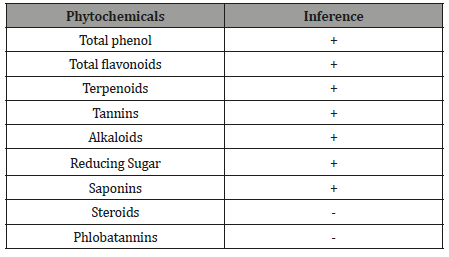
Table 2: Quantitative phytochemical compositions of methanol leaf extract of Gymnema sylveser..
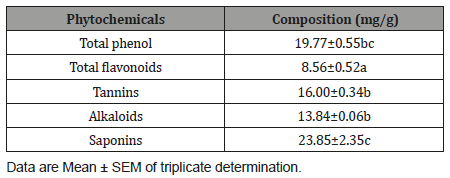
Table 3: Percentage Glucose reduction of methanol leaf extract of Gymnema sylveser in alloxan induced diabetic albino rats..

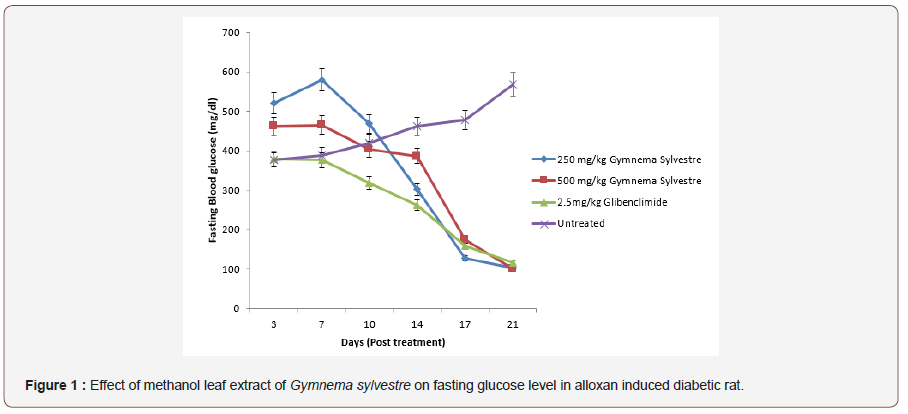
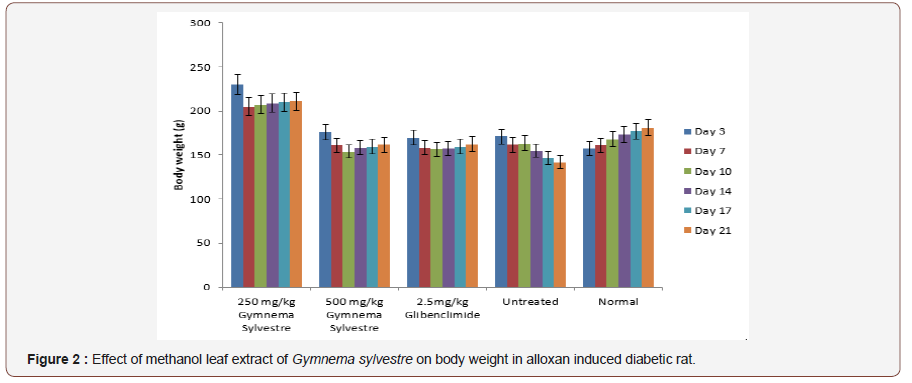
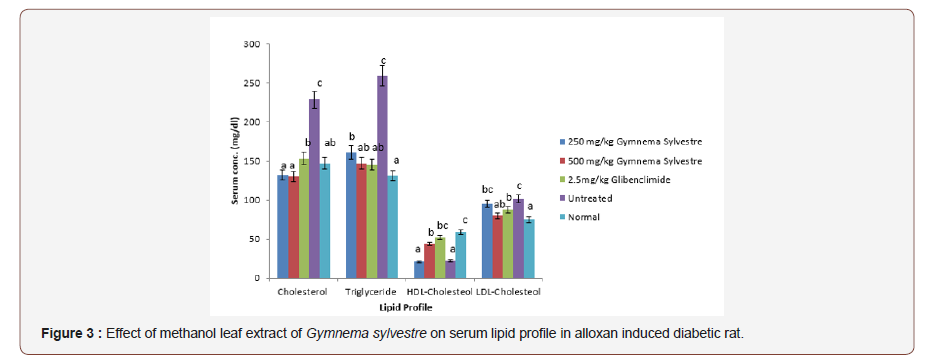
Discussion
Medicinal plants are known to contain diverse bioactive secondary metabolites that confer pharmacological virtues to the plants. Phytochemical screening of methanol leaves extract of G Gymnema sylvestre revealed the presence of appreciable amount of phytochemicals with medicinal reputations (Table 1,2). Saponin which was the most abundant phytochemicals (23.85±2.35 mg/g) in this plant has been previously reported for hyper-cholesterolemic [23]. Flavonoids are water soluble potent scavengers of free radicals and super antioxidant which prevent oxidative cell damage [4]. Furthermore, flavonoids have showed a promising anti-diabetic effect, in diabetic animal models [23]. Previous studies have demonstrated the hypoglycemic activity of triterpenoid glycosides [24]. Therefore, the significant amounts of flavonoids (8.56±0.52 mg/g) and alkaloids (13.84±0.00 mg/g) obtained in this study could indicate strong antioxidant and antidiabetic potentials of this plant. However, the absence of phlobatannins and steroids concord with earlier studies which also reported that not all secondary metabolites are present in all plants and those that present differs according to the solvent use in the extraction process [25].
Results from the present study revealed that administration of alloxan results in hyperglycaemic state as evident in by marked increase in blood glucose level. However, dose dependent reduction in blood glucose level was observed in alloxan-induced diabetic rats treated with methanol leaf extract of Gymnema sylvestres. The significant hypoglycaemic effect of Gymnema sylvestres observed in this study may be linked to the presence of the phytochemicals particularly, flavonoids, alkaloids, sapomnins and terpenes in the extract. These compounds have been implicated in the antidiabetic activities of many plants [26]. The progressive decrease in body weight observed in untreated rats could be due to the deficiency of insulin which enhanced the breakdown of tissue proteins and subsequently resulted into loos of body weight [27]. However, the hypoglycaemia effects demonstrated by the plant extract were complemented by the enhancement in the body weights of the animals (Figure 2). A probable mechanistic approach to this finding could be through pancreatic stimulation which enhanced secretion of insulin and the prevent glucose absorption in the gut as proposed by Tiwari et al. [7].
Abnormal lipid profile has been established to be one of the major complications of diabetic mellitus which in turns results to atherosclerosis and cardiovascular disease. Therefore, plant with antidiabetic properties should possess favourable effect on lipid profiles. Therefore, measurements of the level of serum lipid profile in diabetic treated rats become necessary. In the present study, administration of alloxan leads to significant increase in cholesterol, LDL and triglyceride. These high levels of triglyceride, TC and LDL are major coronary risk factors [19]. However, treatment of methanol, leaf extract of Gymnema sylvestres tend to restore the elevated parameters towards their normal value thereby reflecting the hypolipidemic property of this plant.
The reductions in serum concentration of cholesterol in rats following treatment with the extract could be linked to the presence of flavonoids, tannins and saponins that were reported to inhibit hepatic synthesis of cholesterol [28]. The reduction in triglyceride could also be attributed to the presence of alkaloids and saponins, which inhibit the absorption of dietary glucose in the GIT [29]. The increase in HDL concentration in serum of rats treated of methanol leaf extract of Gymnema sylvestres advocated a probable boost of hepatic HDL-C synthesis promoted by the presence of flavonoids [23]. Hence, more cholesterol would be moved from the peripheral tissues to the liver for excretion and could be responsible for the observed trend in the serum cholesterol concentration.
Conclusion
Methanol leaf extract of Gymnema sylvestres contains important phytochemicals that has beneficial effect in reducing the elevated blood glucose level and significant ameliorative effects on hyperglycemic induced dyslipidemia.
To read more about this article...Open access Journal of Biology & Life Sciences
Please follow the URL to access more information about this article
To know more about our Journals...Iris Publishers





No comments:
Post a Comment